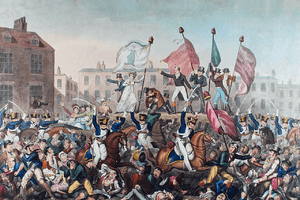Mary Fildes facts for kids
Quick facts for kids
Mary Fildes
|
|
|---|---|

Print of the Peterloo massacre published by Richard Carlile 1819
|
|
| Born |
Mary Pritchard
between 1789 and 1792 Cork, Ireland
|
| Died | 1876 Manchester, England, United Kingdom of Great Britain and Ireland
|
| Nationality | British |
| Occupation | Female reformer |
| Years active | 1819–1843 |
| Known for | President of The Manchester Female Reform Society |
| Spouse(s) | William Fildes |
| Relatives | Luke Fildes (grandson) Luke Fildes (great-grandson) |
Mary Fildes was an important leader in 1819. She was the president of the Manchester Female Reform Society. She played a big part in a large meeting in Manchester that year. This meeting sadly ended in the Peterloo Massacre. Mary was also the grandmother of the famous artist Luke Fildes.
Contents
Mary's Early Life and Family
Mary Pritchard was born in Cork, Ireland. This was between 1789 and 1792. Her family were grocers from Manchester, England. Her relatives were mostly Welsh. This suggests her parents might have been visiting Ireland when she was born.
Mary married William Fildes on March 18, 1808. He was a reed maker. They got married in Stockport, England. Mary and William had eight children together. Their names were James, Samuel, George, Robert, Sarah, Thomas Paine, Henry Hunt, and John Cartwright. James was the father of the artist Luke Fildes.
Mary named her younger children after important political figures. These included John Cartwright, Thomas Paine, and Henry Hunt.
Mary Fildes and the Peterloo Massacre
On August 16, 1819, many working men and women gathered. They met peacefully at St. Peter's Field, near Manchester. A group of female reformers from Manchester marched in. They were with the carriage of the speaker, Henry Hunt. Mary Fildes rode at the front of the carriage. She was waving a flag.
Mary then stood on the platform with her flag. Other women activists were also there. Richard Carlile, a journalist, was at the event. He saw Mary as a brave person. He showed her in an important spot in his print of the event.
The local leaders worried about trouble. They decided to arrest Henry Hunt. They called for soldiers to help. The Manchester and Salford Yeomanry arrived first. After Hunt was arrested, they attacked the platform. They grabbed and destroyed flags. This caused a lot of panic. More soldiers arrived and charged the crowd. This led to more injuries. In total, eighteen people died. Nearly seven hundred people were seriously hurt.
Other female reformers were beaten and arrested. Mary Fildes herself was hit by a police stick. Her flag was taken. She barely escaped being cut by a sword. She hid for two weeks. Later, she told her story in a petition. This was sent to the House of Commons in May 1821.
Mary's Later Political Actions
Mary Fildes was a female reformer. However, she was not a suffragette. Suffragettes fought for women to have the right to vote. Mary believed women should work with men. She thought they should fight for all adult men who owned homes to vote. She believed this would help the whole family.
In 1822, some groups split apart. Mary Fildes sided with Henry Hunt. She accused Richard Carlile of being a coward at Peterloo.
Mary continued to be a reformer. In 1833, she spoke at a meeting in Heywood, Lancashire. This meeting started a new group called the Female Political Union. In 1843, she gave talks about 'War' near Manchester. These talks were advertised in newspapers.
Later Years and Her Grandson, Luke Fildes
Mary Fildes had a comfortable life in her later years. By 1846, she was a widow. She lived in Glasgow, possibly with her husband's relatives. In 1849, she inherited four houses in Chester from her mother. She then moved to Chester.
In 1854, Mary traveled to Liverpool. Her son James lived there. She brought her eleven-year-old grandson, Luke Fildes, to live with her in Chester. Mary paid for Luke to attend art classes. These classes were at Warrington School of Art. This helped him become one of Victorian England's most famous painters. Mary Fildes died in Manchester in 1876.

